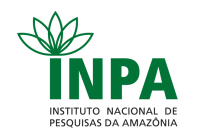Corpo Discente - Egressos
Francisco Geraldo Mello da Rocha Carvalho Neto
| Título | ESTRUTURA GÊNICA E MODELAGEM MOLECULAR DA GLICOQUINASE (GCK) DE Podocnemis unifilis | ||||||||||||||||||||||||
| Data da Defesa | 29/06/2018 | ||||||||||||||||||||||||
| Download | Em sigilo | ||||||||||||||||||||||||
Banca
| |||||||||||||||||||||||||
| Palavras-Chaves | GCK, Podocnemis, genoma, modelagem por homologia | ||||||||||||||||||||||||
| Resumo | A glicoquinase (GCK) é uma enzima responsável por fosforilar a glicose. Embora inicialmente descrita no fígado, ela também está presente nas células beta pancreáticas, nos neurônios, na glândula pituitária e nas células entero-endócrina K e L, sugerindo que uma rede de células GCK agem como um sensor de glicose para a manutenção de sua homeostase. Curiosamente, dois promotores diferentes estão contidos no gene, um ativo nas células β e o outro no fígado. Esse fato oferece uma explicação para a regulação diferencial da GCK nas células β e no fígado. As sequências dos promotores utilizadas no fígado aparentemente permitem a regulação pela insulina, enquanto as sequências dos promotores utilizados nas células β permitem a regulação pela glicose. Dado o seu papel central na regulação da liberação de insulina, torna-se fácil compreender que as mutações na codificação do gene GCK podem causar tanto hiper quanto hipoglicemia, sendo que o tipo de mutação, determinará se a manifestação da hiperglicemia será leve ou severa. Apesar da alta prevalência, a patogênese da hiperglicemia ainda não é completamente compreendida. Por isso, modelos experimentais apropriados são ferramentas essenciais para adquirir mais conhecimento sobre a genética e patogênese. Neste trabalho estamos propondo usar como modelo animal, para estudo do gene GCK, tartarugas do gênero Podocnemis, visto que a metodologia para determinação da atividade da enzima hexoquinase já está bem definida no mesmo. A espécie escolhida foi a P. unifilis, conhecida comumente como “tracajá” e encontrada na bacia hidrográfica do rio Amazonas. Para a obtenção dos espécimes foi realizada uma parceria com o projeto “Pé-de-Pincha”. Na literatura não há relatos sobre o genoma de P. unifilis, sendo, portanto, desconhecida a maioria dos genes expressos para a espécie. Por não haver sequências do gene GCK depositadas para esta espécie, uma parte fundamental desta pesquisa foi o sequenciamento do genoma. Além disso, foi utilizada a técnica de modelagem comparativa, para a elucidação estrutural da enzima GCK, como alvo molecular para estudo do metabolismo da glicose. O objetivo principal deste trabalho foi desenhar um modelo animal que permita estudar mutações de base única no gene GCK. Para isso, foram utilizados filhotes recém-eclodidos com cerca de 30 dias de idade para obtenção do fígado utilizado para os testes moleculares. Os dados encontrados mostraram que a GCK é uma enzima importante para o metabolismo dos carboidratos em P. unifilis e que a técnica de sequenciamento do genoma ajudou a encontrar a região codificadora do gene GCK. Esta região codificadora apresentou 10 éxons, mostrando os sítios de splicing. A partir destes dados foi feita a montagem in silico da sequência de aminoácidos que codifica a GCK de P. unifilis, o que pode futuramente auxiliar a investigação de eventos biológicos em nível molecular para a compreensão global do metabolismo animal da glicoquinase. A técnica de modelagem molecular por homologia permitiu a construção da estrutura molecular do GCK de P. unifilis, resultados esses válidos para posteriores trabalhos de docking molecular e afins. | ||||||||||||||||||||||||
| Abstract | Glycokinase (GCK) is an enzyme responsible for phosphorylating glucose. Although initially described in the liver, it is also present in pancreatic beta cells, neurons, pituitary gland and entero-endocrine K and L cells, suggesting that a network of GCK cells act as a glucose sensor for the maintenance of its homeostasis. Interestingly, two different promoters are present in the gene, one active in β cells and the other in the liver. This fact provides an explanation for the differential regulation of GCK in β cells and in the liver. Promoters sequences used in the liver apparently allow for regulation by insulin, whereas the promoter sequences used in the β cells allow regulation by glucose. Given its central role in regulating insulin release, it is easy to understand that mutations in the coding of the GCK gene may cause both hyper and hypoglycemia, and the type of mutation will determine whether the manifestation of hyperglycemia will be mild or severe. Despite the high prevalence, the pathogenesis of hyperglycemia is still not completely understood. Therefore, appropriate experimental models are essential tools to acquire more knowledge about the genetics and pathogenesis of the disease. In this work we are proposing to use as animal model, for the study of the GCK gene, turtles of the genus Podocnemis, since the methodology for determination of hexokinase activity is already well defined in it. The species chosen was P. unifilis, commonly known as "tracajá" and found in the Amazon river basin. To obtain the specimens a partnership with the "Pé-de-Pincha" project was carried out. In the literature there are no reports on the P. unifilis genome, being therefore unknown the majority of the genes expressed for the species. Because there were no GCK gene sequences deposited for this species, a key part of this research was the sequencing of the genome. In addition, the comparative modeling technique for the structural elucidation of the GCK enzyme was used as the molecular target for the study of glucose metabolism. The main objective of this work was to design an animal model that allows to study single base mutations in the GCK gene. For this, hatchlings were used, which were about 30 days old, to obtain the liver used for the molecular tests. Data found showed that GCK is an important enzyme for carbohydrate metabolism in P. unifilis and that the genome sequencing technique helped to find the coding region of the GCK gene with ease and speed. This coding region showed 10 exons, showing the splicing sites. From these data the in silico assembly of the amino acid sequence coding for GCK from P. unifilis was done, which may in the future assist the investigation of biological events at the molecular level for the global comprehension of animal metabolism of glycokinase. The homology molecular modeling technique allowed the construction of the molecular structure of the GCK of P. unifilis, results valid for later molecular docking and related work. | ||||||||||||||||||||||||
Parceiros

























